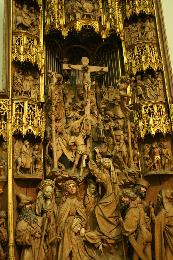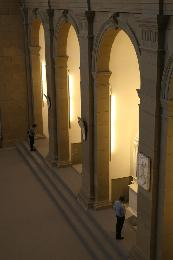Week one of the AY winter core course (Art and Politics in Renaissance Florence) was dedicated to giving students an introduction to art history as well as helping them to understand and begin to practice visual analysis of a work of art. The theoretical knowledge that was gained during the week was put into practice on a visit to the Bode Museum led by Professor Aya Soika. Students tried as much as possible to “read” a particular work of art. Using the information that they managed to draw from a work of art by perceiving it as an object which incorporates characteristics and symbols typical for a certain period of time, students tried to identify the variations of style and the changes that occurred over the course of approximately 100 years.
We began the analysis by recognizing the architectural style of the Bode Museum. It was opened in 1904 and until 1956 was called Kaiser-Friedrich Museum, named after the emperor Frederick III. In 1956 it was renamed Bode Museum, after its first curator Wilhelm von Bode. The grandiose exterior was constructed in the neo-baroque style. The interior style, on the other hand, changes—from the lavishness of the baroque, through the refinement of the classical style to reach a point where it echoes the serenity of a Roman basilic
The first object of our interest was a wooden sculpture, The Virgin with the Dead Christ, dating from 1435—which had been made in Germany. The sculpture is not as elaborate and refined as sculptures produced in Italy in the first half of the fifteenth century – the bodies of the Virgin and Christ were represented in a rather clumsy way. Nevertheless, The Virgin with the Dead Christ bears a striking resemblance to Michelangelo’s Pieta, made in 1499. Michelangelo’s work is made of marble and is much more advanced when it comes to depicting a natural posture in the body of both the Virgin and of Christ. The position of the bodies is the same in both sculptures, and it could be claimed that Michelangelo took a step further in perfecting the already practiced depiction of this scene of lamentation.
Virgin and Child by Giovanni Pisano, made in the second half of the thirteenth century, was the next important sculpture we looked at. It had been commissioned for a cathedral in Pisa. The clear progress in sculpturing is obvious in the careful depiction of the physiognomy of the faces of both Mary and the Christ Child. Pisano emphasized the importance of Christ by “dressing” Him in the robes of a Roman monarch – a symbolic reference to Him as future King of the people.
The urge of the artists to explore new horizons and use their gifts to experiment with representations of reality (in particular perspective), is shown in the Choir Stalls by Bartolomeo de Polli, made around 1500. At first sight there is nothing that would make these choir stalls stand out from other works originating from that period, referred to as “early Renaissance”. However, the scenes chosen to decorate these stalls are not just portraits of saints, as one would expect. The usual portraits of saints alternate with images of everyday life. The reason for this was the artist’s attempt to work with perspective; he chose buildings and scenes that do not strike us as particularly unique to serve his purpose, that is, in order to practice the different techniques of depicting three-dimensional images on a flat surface.
Putto with Tambourine by Donatello is noted for the interesting story behind its journey to the Bode Museum. Originally used as a statuette decorating a Baptismal Font in Siena, it was sold to Wilhelm von Bode as an eighteenth century forgery. Later it was discovered that it is actually an authentic Donatello statuette. It proves the artist’s mastery in depicting a child’s body; the movement of the dancing “Putto” is perfectly captured in bronze. Pazzi Madonna was the next piece by Donatello that was discussed; interesting for the fact that the technique of presenting perspective on a relief was applied to human bodies, i.e. the bodies of Mary and Christ.
The tour continued with a brief reflection on works by Tiepolo and Pacetti. It ended with an observation of wooden carvings dating from the fifteenth century, which are some of the most difficult art objects to preserve.
By visiting the Bode Museum the AY students took their first steps in the realm of visual analysis of art works, beginning the acquisition of a skill that will continue to be practiced during the entire second term.
Elena Volkanovska (2009, Macedonia)

